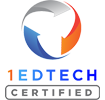If you want to understand the science of something, you can’t just read one research study and then call it a day. You have to dive deep into the literature, no matter how expansive it may be. After all, science is the culmination of iterative exploration.
There is a well-documented science of literacy. And if you want to understand the fascinating science of how children learn to read, you must use a comprehensive approach that prioritizes compilation of ever-changing evidence rather than reliance on a singular source. In other words, read it all!
Understanding the science of reading is crucial to supporting our youngest readers. Literacy attainment is strongly associated with overall academic achievement, economic well-being, civic involvement, health, and social participation. But while some children seem to learn to read quickly and without obstacles, about 30-40% of kids end up needing more explicit assistance.
So, how do we help the kids that struggle? After all, tens of thousands of studies have been published in cognitive psychology, linguistics, and neuroscience on the science of reading and not all come to the same conclusion.
Let’s summarize the research.
According to the National Reading Panel, there are 5 main components to the science of reading:
- Phonemic awareness
- Phonics
- Fluency
- Vocabulary
- Comprehension
Phonemic awareness refers to the ability to identify and manipulate individual sounds in spoken words.
Phonics is the instruction on how combinations of letters link together to form letter-sound relationships and patterns.
Fluency is something that is achieved when you can read words, phrases, and sentences correctly, with speed, and with expression.
Vocabulary is knowing what words mean, how to say them, and how to use them correctly in context.
And lastly, comprehension refers to the ability to process and understand what you are reading.
The evidence suggests that reading should be taught based on these 5 main pillars. So, I guess it’s not just “Hooked on Phonics” anymore!
Scarborough’s Reading Rope is also a theory that draws from the science of reading, albeit with a slightly different reading component breakdown. The main components of the reading rope are A) word recognition, which consists of phonological awareness, decoding, and sight recognition, and B) language comprehension, which consists of background knowledge, vocabulary, language structures, verbal reasoning, and literacy knowledge. To become a skilled reader, these components must be woven together like threads into a singular rope, while the skills developed become increasingly strategic and increasingly automatic.
All these components represent a small portion of the evolving science of reading. But when these evidence-based concepts are applied within reading instruction, 95% of students learn to read proficiently. It’s clear that to improve reading literacy, we must look to the science.
At StrongMind, we develop our curriculum to align with the science of reading.






